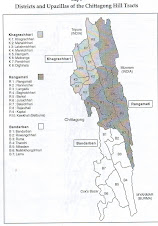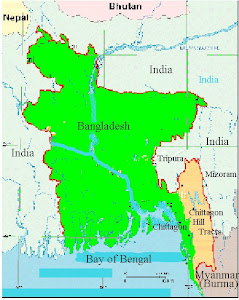Dated:-03/31/2008
To,
MS. HENRIETTA H. FORE
Director of U.S. Foreign Assistance & USAID Administrator
U.S. Department of State
Room 5932
2201 C Street, N.W
Washington , D.C. 20520
Subject: Famine situation in CHTs region of Bangladesh
Dear Madam,
With due humble submission, we would like to put forward a few words to draw your kind attention on a famine like situation among indigenous populations living in remote areas of Chittagong Hill Tracts (CHTs) region of Bangladesh who are starving to death. They need food supply desperately to survive from this situation immediately.
This famine situation has arisen from extensive destruction of crops by acute surge of rat populations in those areas. These are underprivileged indigenous people who lead almost a nomadic life in a hand to mouth situation whole the year round. They reported to the government agencies earlier about a year ago when bamboo flower started to blossom. It was observed in the past that whenever bamboo flowers blossom in a certain year, usually in every 20-40 years, it is always followed by acute increase of rat populations who destroy all the crops and food. As the government agencies did not listen to their appeals on time because of their poor status, now these neglected and deprived people are suffering much from hunger associated with other diseases and conditions, even deaths. Only the wild leaves and roots have kept them alive in the recent months. Very recently, some organizations have started to operate relief operations in a limited scale what is quite inadequate in comparison to actual needs. Moreover, now they have become vulnerable to Bubonic Plague.
In these circumstances, we have an earnest appeal to you to kindly extend your helping hands to save these unfortunate and disastrous people from utmost sufferings from starving and other associated conditions. The USAID Country Representative might be aware of this situation.
It may be mentioned here that these indigenous populations are distinctly different from majority population of Bangladesh in respect of race, religion, culture, and life style. They live in remote areas of the region without electricity, safe water supply, sanitation, schools, and motor driven roads. Furthermore, these are the people who were displaced from their homestead due to decade long socio-political conflict in the region.
An Observation Report by Mr. Mark Dummett, BBC Correspondent, Bangladesh is attached herewith as an outstanding reference to actual situation.
Best regards.
Kirti Ranjan Chakma
President
Prasanjit Chakma
General Secretary
Copy to:
1.Ms. Geeta Pasi
Charge De’ Affaires, a.i
US Embassy, Dhaka, Bangladesh;
2.Dr. Stefan Frowein
Head of Delegation of the European Commission to Bangladesh
House 7, Road 84, Gulshan 2
Dhaka 1212, Bangladesh;
3.Ms. Renata Lok-Dessalien
UN Resident Coordinator to Bangladesh
C/O UNDP
G.P.O Box No. 224, Dhaka 1000, Bangladesh
4.Denise Rollins
Mission Director
USAID/Bangladesh
5.Mr. Doug Foskett
Australian High Commissioner to Bangladesh
184 Gulshan Avenue
Gulshan, Dhaka, Bangladesh
6.Ms. Victoria Tauli-Corpuz
Chief
Secretariat of the Permanent Forum on Indigenous Issues
United Nations, 2 UN Plaza
Room DC2-1772, New York, NY, 10017
7.Mr. Pinak Ranjan Chakravarty
High Commissioner of India
Dhaka, Bangladesh.. MR PINAK RANJAN CHAKRAVARTY, High Commissioner of India
skip to main |
skip to sidebar


Map of Bangladesh

CHTs is number one Milliary zone in the world


Ministry of Chittagong Hill Tracts Affairs
The United Nation
The IJPMNA
This page provides information of the minority Indigenous Jumma Peoples in Chittagong Hill Tracts (CHTs) Bangladesh.
Contact with this please write:-ijpnusa@yahoo.com
Contact with this please write:-ijpnusa@yahoo.com
About Us
Location of Jummaland

Jumma Videos
- The BANDARBAN SADAR
- The Rowangchari
- The Ruma
- The Lama
- The Thanchi
- The Alikadom
- The Naikhkhongchari
- The RANGAMATI SADAR
- The Baghaichari
- The Langudu
- The Nanyachar
- The Barkal
- The Jurachari
- The Bilaichari
- The Kaptai
- The Rajsthali
- The Kawkhali
- The KHAGRACHARI SADAR
- The Manikchari
- The Laksmichari
- The Mahalchari
- The Matiranga
- The Ramgarh
- The Dighinala
- The Panchari
Audio & Video
Jumma Natok (Drama)
International Support
Educational Institution
Religious Organization
Buddhist Studies

Map of Bangladesh
Mission of Bangladesh
About Bangladesh
Bangali Audio Songs
Bengali News

CHTs is number one Milliary zone in the world
Online Audios
Refugee in Homeland

Jumma Picture

Blog Archive
About Me
- The Indigenous Jumma Peoples Movement in North America
- The Chittagong Hill Tracts (CHT) region comprises three districts: Banderban , Khagrachari and Rangamati. The districts comprise seven main valleys formed by the Feni, Karnafuli, Chengi, Myani, Kassalong, Sangu and Matamuhuri rivers aid their tributaries and numerous hills, ravines and cliffs covered with dense vegetation, which are in complete contrast to most other districts of Bangladesh, which consist mainly of alluvial lands. Geographically the CHT can be divided into two broad ecological zones: (a) hill valley, (b) agricultural plains. It is surrounded by the Indian states of Tripura on the north and Mizoram on the east, Myanmar on the south and east and Chittagong district on the west.
